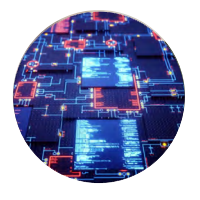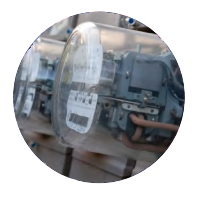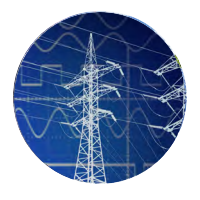REIMAGINE THE GRID FOR A CLEAN FUTURE
This Xtensible utility client provides approximately 15 million people with electricity across a service territory of approximately 50,000 square miles. They are actively looking ahead to create a 21st century power network to handle what seems like ever changing energy needs. Sophisticated technologies will be delivering electricity more reliably than ever, keeping outages to a minimum. They facilitate their customers’ choices in adopting new technologies to generate their own energy and monitoring and controlling their overall usage.
OVERVIEW OF WORKXtensible has been part of their journey for more than 15 years. The services Xtensible has been asked to provide for vastly different projects include architecture, design, integration, analytics, and corporate strategy. Based on their expertise and staffing, our involvement has been adjusted to simply support as well as significant involvement in implementation. As a foundation, Xtensible worked with the utility to architect their Enterprise Analytics Platform. Approximately 10TB of data is now processed on a weekly basis. It is worth pointing out that this utility has adapted the Xtensible MD3i Framework and Toolset for the design and implementation of their data models. We built a CIM based approach and laid the groundwork for expansion. THE FUTUREChanges to the electric grid are necessary and will continue to be needed based on technology advancements and consumer expectations related to reliability and affordability as well as the growing global awareness of environmental impacts. Change will only accelerate. To meet the challenges, all parties need to work together to shape policy and technology. Data model governance is a key factor in long-term success and sets the stage for future expansion and growth, an area where Xtensible has considerable expertise. |

“Xtensible is ready to support the technology challenges through our thought leadership and work leading and participating in international standards committees and other industry wide community initiatives. It is more important than ever to treat data as a valuable asset.” Greg Robinson, President at Xtensible |
 |
WEATHER AND WILDFIRE MODELINGThe Need: Utilities and customers continue to be impacted by wildfires. To mitigate risk and liability, grid resiliency needs to be improved to prevent and monitor fires. The Result: Xtensible developed a data model based on IEC CIM to support both weather and wildfire forecasts. The data model was enhanced with fields such as elevation, humidity, and wildfire related parameters to support a diverse set of use cases. Weather and wildfire analytics and reporting capabilities are available for all customers. |
 |
ADVANCED DISTRIBUTION MANAGEMENT INTEGRATIONThe Need: To integrate the Advanced Distribution Management System (ADMS) to improve reliability, outage management, system optimization, and to leverage Distributed Energy Resources (DERs). The Result: Xtensible provided an industry standard based Common Information Model (CIM) for data exchange between ADMS, Advanced Metering Infrastructure (AMI), Work Management System (WMS), and the Outage Management System (OMS). This common information model enables interoperability among the many enterprise systems and increases reusability to lower overall integration cost. |
 |
GRID CONNECTIVITY MODELThe Need: The Grid Connectivity Model is part of an overall approach to provide an integrated model of the power grid providing end-to-end network connectivity from Transmission to Distribution networks, including DERs. The Result: Xtensible created and implemented a comprehensive electrical connectivity model to include both transmission and distribution networks. The IEC CIM connectivity model was utilized, extended and specialized to address data requirements for both data-at-rest (e.g. database model) and data-in-motion (e.g. XSD or JSON) needs. The Grid Connectivity Model provides a common data dictionary for data coming from different systems such as the Energy Management System (EMS), the Geographic Information System (GIS), and the Enterprise Asset Management (EAS) system. |
 |
ENERGY ANALYTICS PLATFORMThe Need: Data analysis and analytics plays a key role for electric planning for both transmission and distribution. An Enterprise Analytical Platform (EAP) and its associated tools provide solutions to support this planning. It also provides capabilities and functions critical to several enterprise systems such as ADMS and many engineering analysis systems. The Result: Xtensible worked with the business teams and performed data analysis to build several extensible aggregation-layer dimensional models. This includes models for long-term planning, transformer load percentage, SCADA and AMI profiles. A pattern has been developed for both historical and forecast dimensional models to address the complexity of ever-changing business requirements. |
 |
PUBLIC SAFETY POWER SHUTOFFThe Need: With the continuing threat of wildfire, utilities may proactively cut power to electrical lines that may fail in certain weather conditions to reduce the likelihood that their infrastructure could cause or contribute to a wildfire. Reporting of these events have been inconsistent resulting in difficulty analyzing and learning from the data. The Result: Xtensible in close cooperation with the utility is developing processes, procedures, data governance and building and extending the IEC CIM standards-based model to allow for stakeholders to process and make informed decision, ultimately resulting in extended grid resilience, fewer as well as targeted public safety power shutoffs. |
 |
LOAD AND DER REGISTRATION CAPABILITIESThe Need: Customers are requesting to interconnect DERs to the electrical system under various interconnection tariffs established by different states. An interconnection processing tool is needed to provide load and DER registration capabilities. The Result: Xtensible has been supporting the design process leading to its release. Data analysis has been performed on the DER related data fields presented in the tariffs. A resulting DER model has been created and submitted to the IEC CIM standards organization for inclusion. |
 |
ENGINEERING ANALYSISThe Need: Engineering Analysis needs to provide several services such as for instance capacity analysis. The capacity analysis identifies the capability of electrical system to integrate DERs within thermal ratings, power quality, system protection limits, and safety standards of existing equipment. The Result: Xtensible team has been supporting the architecture design process to adopt the TOGAF architecture framework and to build the Release Architecture designs using the ArchiMate language. This allows for modeling business services, functions and application components following the TOGAF principles to cover all business, application, and technology layers. |






